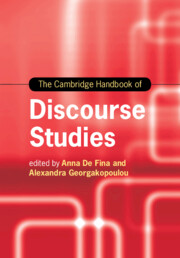Book contents
- The Cambridge Handbook of Discourse Studies
- Cambridge Handbooks in Language and Linguistics
- The Cambridge Handbook of Discourse Studies
- Copyright page
- Contents
- Figures
- Tables
- Contributors
- Preface
- Part I (Con)Textualizing Discourses
- 1 Registers, Styles, Indexicality
- 2 Situating Discourse Analysis in Ethnographic and Sociopolitical Context
- 3 Context and Its Complications
- 4 Historicity, Interdiscursivity and Intertextuality in Discourse Studies
- 5 Rethinking Narrative: Tellers, Tales and Identities in Contemporary Worlds
- Part II Perspectives and Modes of Analysis
- Part III Discourse Materialities and Embodiment
- Part IV (Trans)Locations and Intersections
- Part V Ethics, Inequality and Inclusion
- Part VI Discourses, Publics and Mediatization
- Index
- References
2 - Situating Discourse Analysis in Ethnographic and Sociopolitical Context
from Part I - (Con)Textualizing Discourses
Published online by Cambridge University Press: 28 September 2020
- The Cambridge Handbook of Discourse Studies
- Cambridge Handbooks in Language and Linguistics
- The Cambridge Handbook of Discourse Studies
- Copyright page
- Contents
- Figures
- Tables
- Contributors
- Preface
- Part I (Con)Textualizing Discourses
- 1 Registers, Styles, Indexicality
- 2 Situating Discourse Analysis in Ethnographic and Sociopolitical Context
- 3 Context and Its Complications
- 4 Historicity, Interdiscursivity and Intertextuality in Discourse Studies
- 5 Rethinking Narrative: Tellers, Tales and Identities in Contemporary Worlds
- Part II Perspectives and Modes of Analysis
- Part III Discourse Materialities and Embodiment
- Part IV (Trans)Locations and Intersections
- Part V Ethics, Inequality and Inclusion
- Part VI Discourses, Publics and Mediatization
- Index
- References
Summary
In this chapter, I offer examples of ethnographic approaches to discourse, focusing in particular on how linguistic anthropologists have engaged with and expanded upon the concepts and theoretical tools offered by Goffman and Bakhtin. This includes attention to how Goffman unpacks interactional participant roles, how his concept of footing has been critical to recent interest in stance, and also how speakers linguistically shift in and out of registers. Drawing on Bakhtin, discourse analysts have turned to explore the productive concepts of genre, intertextuality, voicing and chronotopes. Ethnographic discourse analysis connects levels of discourse and context and relies on specific methodological strategies to capture the dynamic ethnographic and sociopolitical contexts within which language is located and to which it contributes and responds.
Keywords
- Type
- Chapter
- Information
- The Cambridge Handbook of Discourse Studies , pp. 32 - 51Publisher: Cambridge University PressPrint publication year: 2020
References
Further Reading
Hilary Parsons Dick shows how speakers evoke chronotopic distinctions between tradition (“here”) and progress (“there”) to situate themselves in relation to the ever-present reality of transnational migration.
This is a multi-sited exploration of face-to-face and online discourse surrounding African American women’s hair care that attends to how women negotiate identity, professional expertise and US race relations.
The authors illustrate how speakers invoke and then contrast “racist” and “anti-racist” voices in their daily speech in order to display their own racial consciousness.
References
- 3
- Cited by



